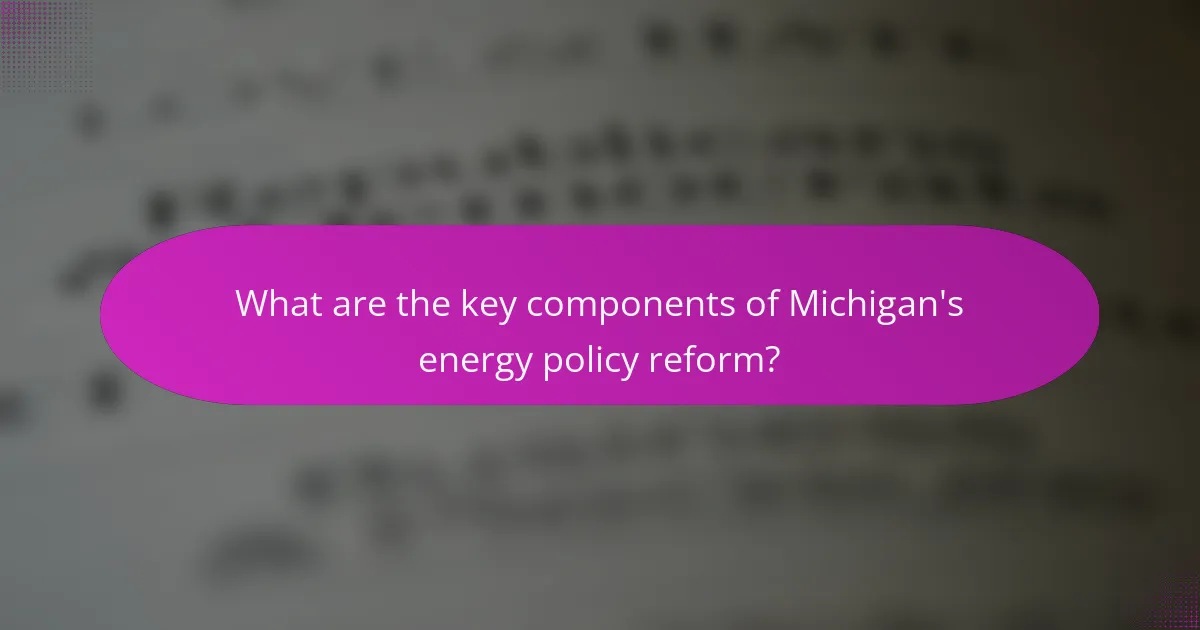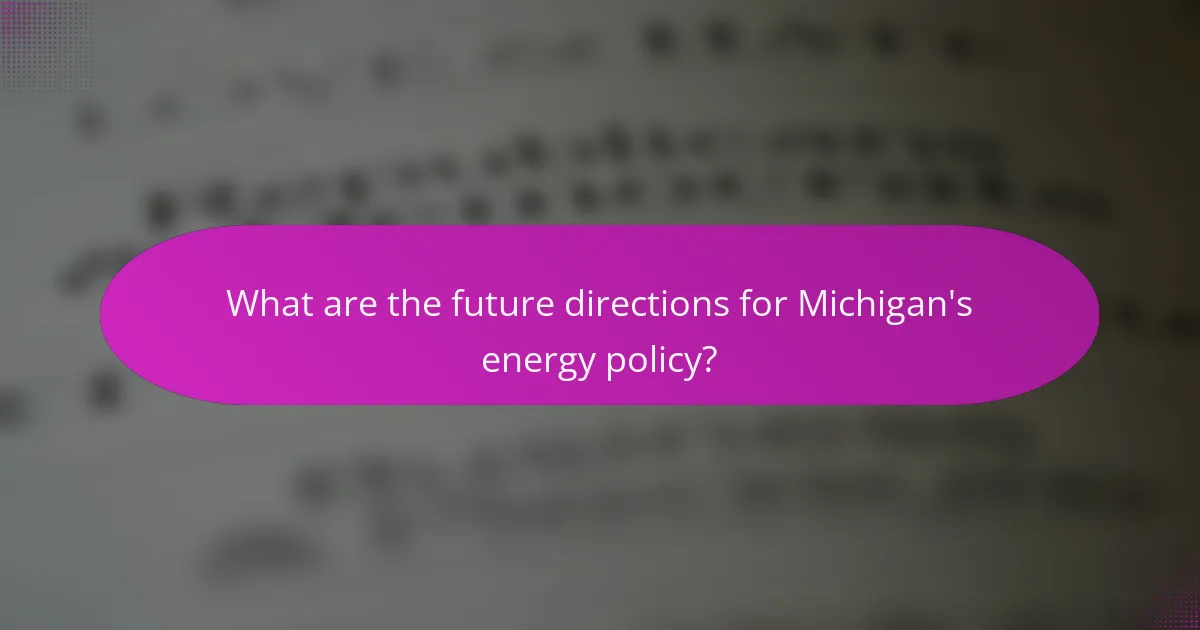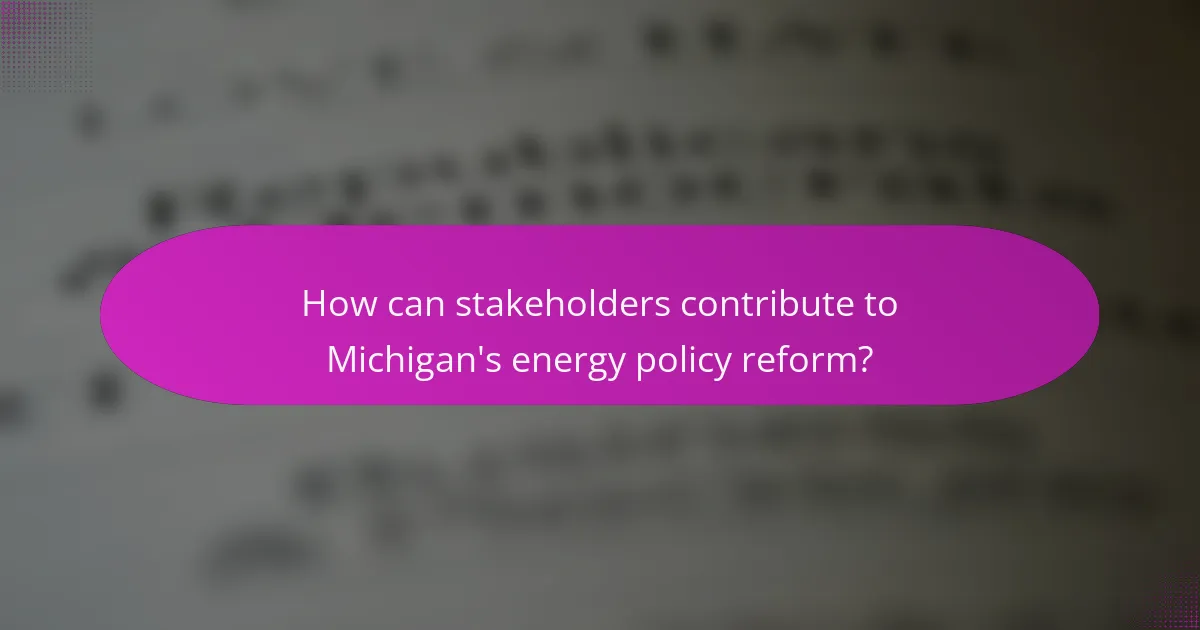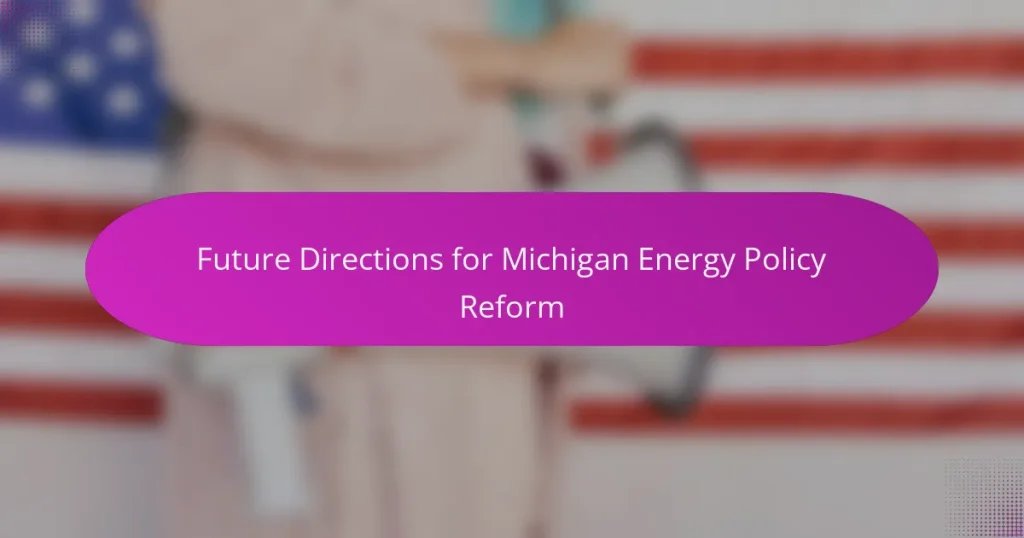
What are the key components of Michigan’s energy policy reform?
Michigan’s energy policy reform includes several key components. These components focus on enhancing renewable energy sources, improving energy efficiency, and ensuring equitable access to energy. The state aims to increase its renewable energy portfolio to 50% by 2030. This goal aligns with national trends towards sustainability and reduced carbon emissions. Energy efficiency programs are designed to reduce consumption and lower costs for consumers. Additionally, the reform emphasizes the importance of community engagement in energy planning. These components reflect a comprehensive approach to modernizing Michigan’s energy landscape.
How does Michigan’s energy policy align with national trends?
Michigan’s energy policy aligns with national trends by emphasizing renewable energy and energy efficiency. The state has set a goal to achieve 50% renewable energy by 2030. This mirrors the national push for increased renewable sources, as seen in the Biden administration’s clean energy initiatives. Michigan’s commitment to reducing carbon emissions also reflects the national trend towards climate action. Additionally, the state supports electric vehicle adoption, similar to federal incentives promoting EV use. These actions demonstrate Michigan’s alignment with broader national energy goals focused on sustainability and innovation.
What federal regulations influence Michigan’s energy policy?
Federal regulations that influence Michigan’s energy policy include the Clean Air Act and the Energy Policy Act. The Clean Air Act sets national air quality standards that impact energy production methods. The Energy Policy Act promotes energy efficiency and renewable energy sources. These regulations guide Michigan’s approach to reducing emissions and increasing sustainable energy use. Additionally, federal incentives for renewable energy development shape Michigan’s energy landscape. Compliance with these regulations is essential for state energy programs and utility operations.
How do state-level initiatives compare with federal guidelines?
State-level initiatives often provide more specific and localized regulations compared to broader federal guidelines. Federal guidelines set minimum standards that states must adhere to. However, states can implement stricter measures tailored to their unique circumstances. For example, Michigan may establish renewable energy targets that exceed federal requirements. This allows states to address local environmental and economic needs more effectively. In some cases, state initiatives may also lead to innovative practices not covered by federal guidelines. Overall, state-level initiatives can complement and enhance federal policies by focusing on regional priorities and challenges.
What challenges does Michigan face in energy policy reform?
Michigan faces several challenges in energy policy reform. One major challenge is the state’s aging infrastructure. Much of Michigan’s energy grid is outdated, requiring significant investment for modernization. Another challenge is balancing energy affordability and sustainability. Residents are concerned about rising energy costs while also wanting cleaner energy sources.
Political dynamics also complicate reform efforts. There is often disagreement among lawmakers regarding the best approach to energy policy. Additionally, stakeholder interests, including utilities and environmental groups, can create conflicts.
Public awareness and engagement in energy issues remain limited. Many residents may not fully understand the implications of energy policy changes. Finally, regulatory hurdles can slow down the implementation of new energy initiatives. These challenges must be addressed to achieve effective energy policy reform in Michigan.
What economic factors impact energy policy decisions in Michigan?
Economic factors that impact energy policy decisions in Michigan include energy prices, job creation, and investment in renewable energy. Energy prices influence consumer behavior and utility rates. High energy costs can drive policymakers to seek alternative energy sources. Job creation in the energy sector can lead to support for policies that promote local energy production. Investment in renewable energy technologies is crucial for economic growth and sustainability. According to the Michigan Energy Innovation Business Council, the clean energy sector has created over 100,000 jobs in the state. Additionally, federal and state incentives for renewable energy projects can shape policy decisions by making them financially attractive.
How do environmental concerns shape energy policy reform?
Environmental concerns significantly influence energy policy reform by driving the need for sustainable practices. Policymakers prioritize reducing greenhouse gas emissions to combat climate change. This prioritization leads to the adoption of renewable energy sources like wind and solar. For instance, Michigan’s commitment to increasing renewable energy to 50% by 2030 reflects these concerns. Additionally, public demand for cleaner air and water pushes for stricter regulations on fossil fuel usage. Studies show that states with strong environmental policies often experience economic growth in green sectors. Therefore, environmental concerns are central to shaping effective energy policies.

What are the future directions for Michigan’s energy policy?
Michigan’s energy policy is shifting towards increased renewable energy adoption. The state aims to achieve a 50% renewable energy target by 2030. This goal aligns with broader national trends towards sustainability. Additionally, Michigan is focusing on reducing greenhouse gas emissions by 28% from 2005 levels by 2025. The state is also investing in energy efficiency programs to lower overall consumption. Expanding electric vehicle infrastructure is another key direction. These initiatives are supported by legislation promoting clean energy investments. Overall, Michigan’s energy policy is moving towards a more sustainable and resilient future.
How can renewable energy sources be integrated into Michigan’s energy policy?
Renewable energy sources can be integrated into Michigan’s energy policy through legislative support and incentives. The state can implement policies that promote solar, wind, and biomass energy. For instance, Michigan can establish renewable portfolio standards. These standards require utilities to obtain a specific percentage of energy from renewable sources. Additionally, financial incentives can encourage private investments in renewable technologies. Tax credits and grants can lower the initial costs for businesses and homeowners. Furthermore, public awareness campaigns can educate citizens about the benefits of renewable energy. This approach can increase community support for renewable projects. According to the Michigan Energy Innovation Business Council, transitioning to renewable energy can create thousands of jobs. Integrating these sources will also help Michigan meet its greenhouse gas reduction goals.
What role do solar and wind energy play in future reforms?
Solar and wind energy are essential for future reforms in Michigan’s energy policy. They contribute to reducing greenhouse gas emissions significantly. According to the U.S. Department of Energy, renewable energy sources can lower emissions by up to 80% by 2050. Solar and wind energy also enhance energy independence and security. Michigan aims to increase its renewable energy portfolio to 50% by 2030. This shift will create jobs in the clean energy sector. Investments in solar and wind infrastructure can stimulate local economies. Overall, these energy sources are crucial for achieving sustainable development goals in Michigan.
How can energy efficiency measures enhance Michigan’s energy landscape?
Energy efficiency measures can significantly enhance Michigan’s energy landscape by reducing overall energy consumption. These measures lower utility bills for consumers and businesses. Improved energy efficiency helps decrease greenhouse gas emissions. According to the Michigan Energy Efficiency Program, energy efficiency initiatives can reduce electricity demand by up to 1,200 megawatts by 2025. This reduction can lead to a more stable energy grid. Additionally, energy efficiency upgrades can create jobs in the construction and manufacturing sectors. Enhanced efficiency also supports the transition to renewable energy sources by reducing reliance on fossil fuels. Overall, energy efficiency measures foster a sustainable energy future for Michigan.
What are the potential impacts of energy policy reform on Michigan’s economy?
Energy policy reform can significantly impact Michigan’s economy. These reforms can lead to job creation in renewable energy sectors. For example, the solar and wind industries are expanding rapidly. Transitioning to clean energy sources can also reduce energy costs for consumers. A study by the Michigan Energy Innovation Business Council found that clean energy jobs grew by 15% from 2019 to 2020. Additionally, energy policy reform can attract investments in technology and infrastructure. This can stimulate local economies and enhance energy independence. Overall, effective energy policy reform can drive sustainable economic growth in Michigan.
How might job creation be affected by new energy policies?
New energy policies can significantly influence job creation. Transitioning to renewable energy sources typically generates more jobs than fossil fuel industries. For instance, the Solar Foundation’s National Solar Jobs Census reported a 20% increase in solar jobs from 2016 to 2017. These policies often promote energy efficiency, which can create jobs in retrofitting and building upgrades. Additionally, investments in new energy technologies can stimulate economic growth and job creation in related sectors. A study by the International Renewable Energy Agency found that renewable energy jobs could reach 24 million globally by 2030. Thus, new energy policies can lead to substantial job growth in various sectors.
What economic incentives can support energy policy reform?
Economic incentives that can support energy policy reform include tax credits, subsidies, and grants for renewable energy projects. These financial tools encourage investment in clean energy technologies. For example, the federal Investment Tax Credit offers a 26% tax credit for solar energy systems installed by 2022, incentivizing solar adoption. Additionally, performance-based incentives reward energy efficiency improvements, promoting reduced consumption. States like Michigan can implement feed-in tariffs to guarantee payments for renewable energy producers, ensuring stable revenue. Research shows that such incentives can significantly increase renewable energy capacity and reduce greenhouse gas emissions.

How can stakeholders contribute to Michigan’s energy policy reform?
Stakeholders can contribute to Michigan’s energy policy reform by actively participating in policy discussions and providing feedback. They can share insights based on their expertise and experiences in the energy sector. Collaboration among stakeholders helps identify effective strategies for energy efficiency and renewable energy adoption.
Public utilities, businesses, and environmental organizations can offer data on energy consumption and potential savings. Their input can guide the development of regulations that balance economic growth with environmental sustainability.
Additionally, stakeholders can advocate for community engagement initiatives. Engaging the public fosters transparency and builds trust in the policy-making process.
Research shows that inclusive policy development leads to better outcomes. For example, a study by the Michigan Energy Office highlights the importance of stakeholder engagement in achieving energy goals.
What role do local governments play in shaping energy policy?
Local governments play a crucial role in shaping energy policy by implementing regulations and initiatives tailored to their communities. They influence energy efficiency programs and renewable energy adoption through local ordinances. Local governments can also facilitate public engagement in energy planning. They often collaborate with state and federal agencies to align policies. Additionally, local governments may provide incentives for businesses and residents to adopt sustainable practices. According to the National League of Cities, over 50% of cities have adopted climate action plans that include energy policies. This demonstrates their active involvement in energy governance and sustainability efforts.
How can community engagement influence energy policy decisions?
Community engagement can significantly influence energy policy decisions by ensuring that the voices of stakeholders are heard. Engaged communities can provide valuable insights into local energy needs and preferences. This involvement fosters transparency and accountability in the decision-making process. Studies show that policies shaped by community input are more likely to gain public support and be effectively implemented. For instance, the Michigan Public Service Commission has highlighted community engagement as a vital component for successful energy initiatives. Engaging residents can lead to more equitable and sustainable energy solutions. Furthermore, community feedback can help policymakers identify potential challenges and opportunities in energy policy. Overall, active participation of communities leads to more informed and relevant energy policies.
What partnerships are essential for successful energy reform?
Collaboration between government agencies, private sector companies, and non-profit organizations is essential for successful energy reform. Government partnerships provide regulatory frameworks and incentives for renewable energy adoption. Private sector involvement drives innovation and investment in clean technologies. Non-profit organizations advocate for sustainable practices and community engagement. Successful examples include the partnership between the Michigan Public Service Commission and energy providers. This collaboration has led to increased renewable energy capacity in Michigan. Effective energy reform relies on these diverse partnerships to address challenges and implement solutions.
What best practices should be considered for effective energy policy reform?
Effective energy policy reform should prioritize stakeholder engagement, data-driven decision-making, and clear regulatory frameworks. Engaging stakeholders ensures that diverse perspectives inform policy development. Data-driven decision-making allows for evidence-based strategies that enhance efficiency and effectiveness. Clear regulatory frameworks provide stability and predictability for investors and consumers. Additionally, policies should support renewable energy integration and encourage energy efficiency programs. A focus on equity ensures that all communities benefit from energy reforms. These best practices are essential for creating a sustainable and resilient energy future.
How can transparency and accountability improve policy outcomes?
Transparency and accountability can significantly enhance policy outcomes by fostering trust and engagement among stakeholders. When policymakers are transparent, they openly share information about decision-making processes and outcomes. This openness allows citizens to understand the rationale behind policies. It also encourages public participation, leading to more informed and relevant policy decisions.
Accountability ensures that policymakers are held responsible for their actions. When officials know they will be scrutinized, they are more likely to make decisions that reflect the public’s best interests. This dynamic can lead to improved efficiency and effectiveness in policy implementation.
Research indicates that transparent governance can reduce corruption and increase public satisfaction with government services. A study by the World Bank found that countries with higher levels of transparency experienced better governance outcomes. Thus, integrating transparency and accountability into Michigan’s energy policy reform can lead to more effective and equitable energy solutions.
What lessons can be learned from other states’ energy reforms?
States that have implemented energy reforms offer several valuable lessons. First, successful reforms often prioritize renewable energy integration. For example, California’s aggressive renewable portfolio standards have led to significant increases in solar and wind energy usage. Second, stakeholder engagement is crucial. New York’s Reforming the Energy Vision initiative involved extensive public input, resulting in more broadly accepted policies. Third, regulatory flexibility can enhance innovation. Massachusetts has adopted a flexible regulatory framework that encourages new technologies. Fourth, energy efficiency programs yield substantial savings. According to the American Council for an Energy-Efficient Economy, states with strong efficiency programs see reduced overall energy consumption. Lastly, monitoring and evaluation are vital for ongoing improvement. States like Oregon regularly assess their energy policies to adapt to changing circumstances. These lessons highlight the importance of comprehensive, inclusive, and adaptable approaches in energy reform efforts.
What steps can individuals take to support Michigan’s energy policy reform?
Individuals can support Michigan’s energy policy reform by engaging in advocacy efforts. They can contact their local representatives to express support for renewable energy initiatives. Participation in community meetings allows individuals to voice opinions on energy policies. Joining local environmental organizations amplifies collective action for reform. Educating oneself on Michigan’s energy issues enhances informed discussions with peers. Supporting clean energy projects through investments or participation fosters sustainable practices. Lastly, voting in elections for candidates who prioritize energy reform is crucial. Each of these steps contributes to a stronger push for effective energy policy changes in Michigan.
The main entity of the article is Michigan’s energy policy reform. This article provides a detailed overview of the key components of Michigan’s energy policy, which include a goal of achieving 50% renewable energy by 2030, enhancing energy efficiency, and ensuring equitable access to energy. It discusses how Michigan’s policies align with national trends, the influence of federal regulations, and the challenges the state faces, such as aging infrastructure and political dynamics. Additionally, the article explores the economic impacts of energy reforms, the role of stakeholders, and best practices for effective policy implementation, emphasizing the importance of community engagement and transparency in shaping future energy initiatives.


